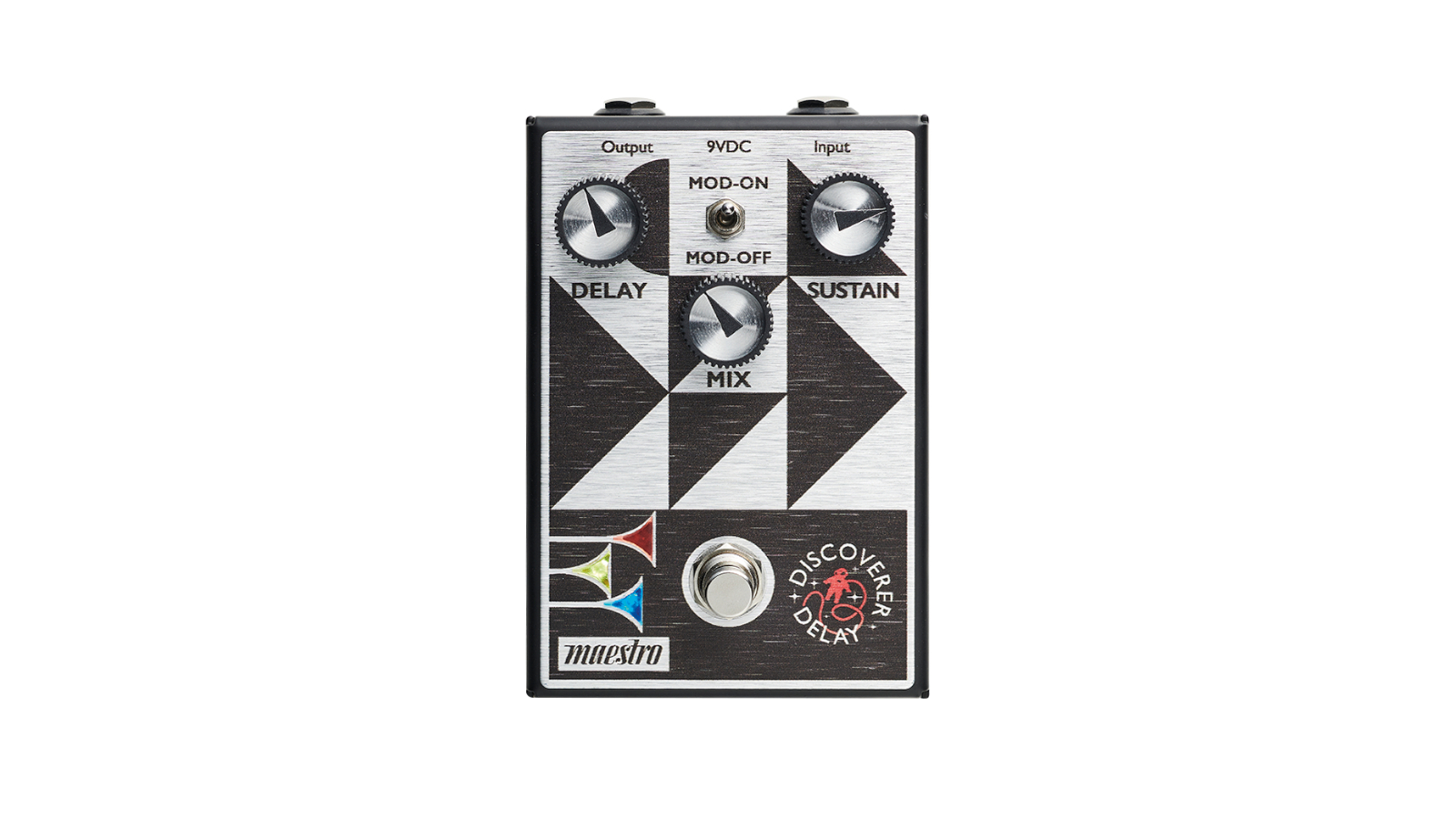GuitarPlayer Verdict
If you’re shopping in the delay end of the stomp-box pool, the Maestro Discoverer Delay is worth a listen.
Pros
- +
Nice sounding analog delay with or without chorus
- +
Quiet operation
Cons
- -
No tap-tempo or provision for preserving delay tails when effect is bypassed
You can trust Guitar Player.
Gibson launched the Maestro brand in 1962 and set the stage for stomp-box effects with its introduction of the FZ-1 Fuzz Tone, a two-knob box that etched its place in history thanks to Keith Richards’ use of it in 1965 on “(I Can’t Get No) Satisfaction,” the Rolling Stones’ first number one hit.

Maestro went on to produce numerous products – including amplifiers – throughout the ’60s and ’70s before fading away in 1979.
Now Gibson has revived the brand with a series of pedalboard-friendly stompboxes for 2022: the FZ-M Fuzz-Tone, Invader Distortion, Ranger Overdrive, Comet Chorus and Discoverer Delay.
While only the FZ-M is actually based on anything Maestro originally did, these colorful pedals exude vintage-style graphics, including a “three bugles” bypass indicator that lights up in red, yellow and blue.

All have three knobs, a two-position mode switch that performs different functions depending on the effect, true-bypass switching and a mechanical on/off foot switch.
They feature analog circuitry, which is laid out on glass-epoxy boards, and the housings open up clamshell-style to make it easy to change the battery (a 2.1mm jack for an external adapter is also provided).
We tested the Maestros using a new Reverend Reeves Gabrels Dirtbike Royale with MojoTone hum-canceling P-90s, a Hamer Newport with Duncan Phat Cat pickups and an early Gibson Johnny A. electric guitar.
All the latest guitar news, interviews, lessons, reviews, deals and more, direct to your inbox!
Everything was run through either a Fender Deluxe Reverb reissue tube amp with Alessandro hand-wired circuitry or a Victoria Double Deluxe 2x12 combo with Celestial Heritage speakers.

In designing a delay pedal to round out the series, Maestro chose to go fully analog with the Discoverer and take advantage of what bucket-brigade technology has to offer.
“We really wanted to lean into the analog aspect of this pedal,” said Gibson’s director of engineering, Craig Hockenberry.
“Whereas a lot of delays that are using the bucket-brigade approach will try to make the sound as pristine as possible, we thought it would be cool to re-create the vibe of vintage echo devices, such as the original Echoplex.
“I think the Discoverer is somewhat unique in that regard.”

The Discoverer looks disarmingly simple with its complement of delay, sustain (repeats) and mix knobs, and a Modulation on/off switch.
With the modulation off, the pedal has a clear delay sound that travels from short slap-echo to ambient delays of up to 600ms. You can get practically endless repeats by turning up the sustain knob.
However, since this pedal is true-bypass (as are all the units in the group), there is no provision, such as a buffered-bypass option, that would enable the delay tails to fade off when the effect is bypassed.
The repeats also have a crispness to them that remains present throughout the decay envelope instead of becoming progressively grungier, as you might expect.
We thought it would be cool to re-create the vibe of vintage echo devices, such as the original Echoplex
Craig Hockenberry
Of course, the Discoverer does all the usual “spaceship” stunts when you max the sustain and mix controls and sweep the delay knob.
Activating the modulation adds chorusing to the delay, which provides a chewy, lo-fi texture that sounds good (though not necessarily tape-like) at lower settings – especially for giving texture to rhythm parts.
As the name implies, however, the Discoverer has the ability to venture beyond chorusing, and this is courtesy of its internal depth and rate trimpots, which are potent functions that can alter the modulation to the point of becoming sound-effecty if you get carried away tweaking their settings.
The Modulation mode definitely allows the Discoverer to venture outside the purview of pure analog echo, and if that was the intent of the designers, they’ve largely succeeded.
By all means, if you’re shopping in the delay end of the stomp-box pool, the Discoverer is worth a listen.

Specifications:
- CONTROLS: Delay, sustain, mix. Mod On/Mod Off switch
- SIZE: 4.75” x 3.25”
- I/O: Front-mounted input, output and power-supply jacks
- EXTRAS: Internal trimpots for adjusting mod depth and speed. Unique “three bugles” bypass LED. Can operate on 9V battery
Visit Maestro for more information.

Art Thompson is Senior Editor of Guitar Player magazine. He has authored stories with numerous guitar greats including B.B. King, Prince and Scotty Moore and interviewed gear innovators such as Paul Reed Smith, Randall Smith and Gary Kramer. He also wrote the first book on vintage effects pedals, Stompbox. Art's busy performance schedule with three stylistically diverse groups provides ample opportunity to test-drive new guitars, amps and effects, many of which are featured in the pages of GP.

